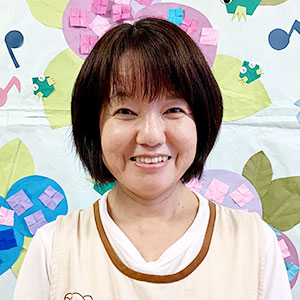Childcare workers continue working while fighting with fear
Takako Muto
Secretary general, Jichiroren Childcare sector members’ group
 Schools and public facilities throughout the country were shut down due to the spread of the novel coronavirus in March and a stay-at-home request by the national government in April. Daycare facilities were requested to either be closed or ask families to refrain from sending their children to the facilities as much as possible. As a result, they had about 20-30% of children attending during the period of the request, although the rate varied by municipality and facility.
Schools and public facilities throughout the country were shut down due to the spread of the novel coronavirus in March and a stay-at-home request by the national government in April. Daycare facilities were requested to either be closed or ask families to refrain from sending their children to the facilities as much as possible. As a result, they had about 20-30% of children attending during the period of the request, although the rate varied by municipality and facility.
During the period, childcare centers tried to avoid “Three Cs (closed spaces, crowded places, and close-contact settings)” and disinfect their spaces. Unfortunately, they had to cancel or reduce sizes of their annual events, such as graduation and entrance ceremonies.
Some facilities were set up for children of healthcare workers whose daycare centers had been closed, and public childcare workers were sent there for help.
Winning exemption from job duties and special leaves nationwide
While working every day, childcare workers are still fighting with fear that children might be infected. A pregnant employee who was concerned about possible infection had no choice but to take annual paid holidays.
During the period of voluntary restraint with less children attending, many childcare workers were forced to take annual paid leaves. However, labor-management negotiations were conducted in many places so that childcare workers were allowed to apply for exemption from their duties and work from home. Workers’ annual paid leaves that had been taken can be counted as special leaves, through the negotiations.
Following some local authorities’ decision to provide 60% of wages for childcare workers on special leaves and for temporary workers of closing daycare centers, union members had negotiations with the local governments on the unfair treatment and won 100% of payments. Thanks to the union activities, its membership has increased.
Leaning lessons from pandemic and calling for childcare services with less pressure
Through the pandemic, I was reminded by the fact that there are too few local government employees.
In some municipalities, employees at their main offices’ childcare departments were too busy dealing with Covid-19 cases to read through daily reports submitted by childcare workers and fully understand situations on the ground. Now, non-regular childcare staff account for around 70 to 80% of the total staff in number at some local governments, and there are many facilities in which half the number of regular workers is in their 20s.
As the voluntary-restraint period created small class sizes at childcare facilities, more people realized that a class with less children allows childcare services with less pressure.
In order to ensure childcare services that can respond to daily-changing situations and provide support for parents and their children, we need to request a better working structure for childcare workers and to achieve increase in the number of staff and improvement of workplaces.
In addition, some childcare centers are suffering from financial stress as they are using their own supplies budgets for the purchase of disinfectant solutions and other items. Consequently, some of staff have to spend their own money on masks and hand sanitizers for work. National and local governments must secure and provide such items for them.
